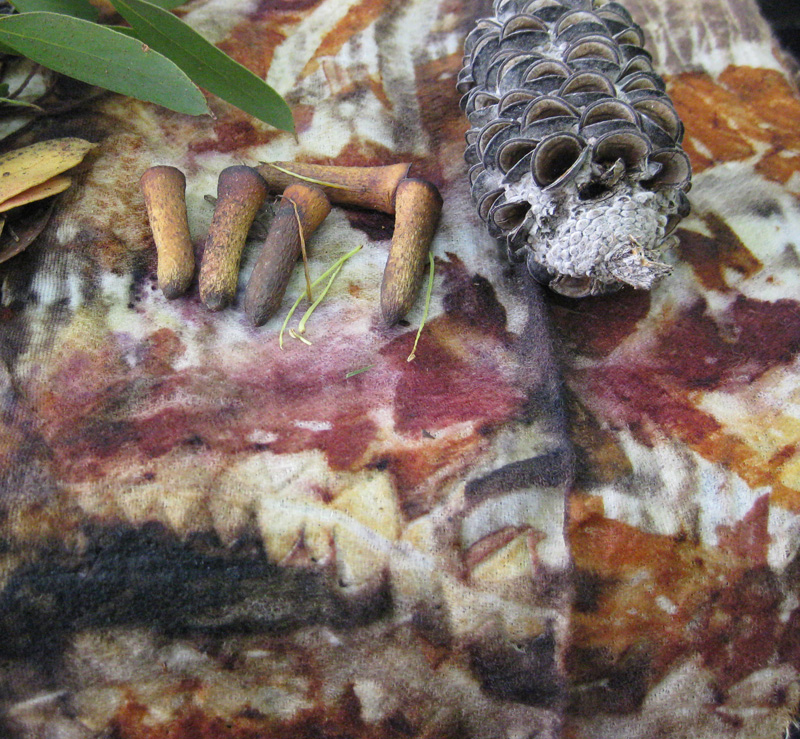
After spending weeks winding 5 gram samples of wool and dyeing so many trial runs to get the perfect and difficult colours for my current tapestry, the thought of just sitting at the loom weaving for the rest of the year seemed a trifle TOO BORING!
Warnambool Tafe had organized a 5 day workshop with India Flint. ‘Botanical Alchemy: an introduction to ecologically sustainable dyes for textiles’ ‘Landskins’ a class combining felt, stitch and dye in the making of felted, stitched and dyed soft felt wraps. I decided that I needed to go and play at something different and this was an opportunity too good to miss! I took along with me a variety of metal pots, copper, brass, iron, stainless steel and tin. Dried mistletoe from the trees at home simmer slowly in the brass pot below. No chemical mordant's are used, the dye vessel acts as the mordant.
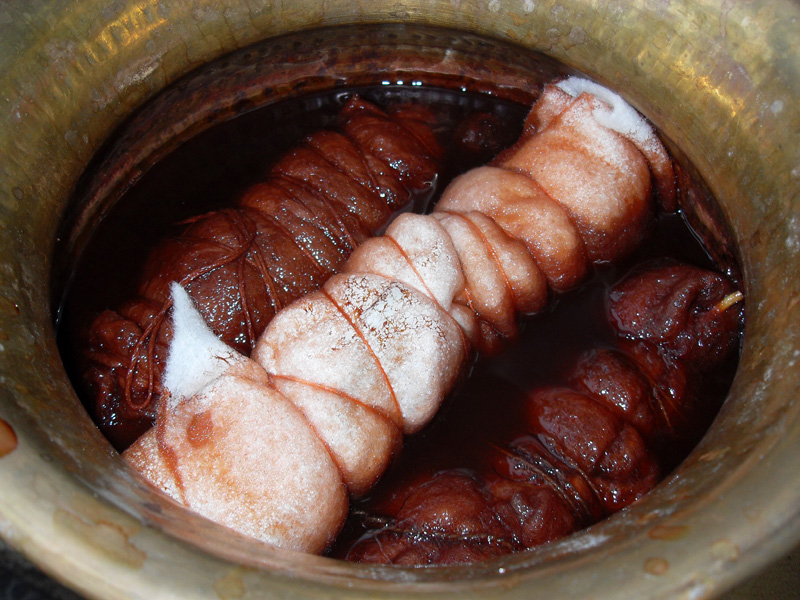
I was asked by one of the students what mistletoe looks like. Amyema miraculosa or red flowering mistletoe is a parasitic plant, spread by birds, it grows like a candelabra on gumtrees in areas of natural forest or roadside trees. I was surprised to drive all the way home from Warrnambool and not see any until the outskirts of Ararat. The hour and a half drive is through a region that has no natural forest or trees apart from what has been planted as windbreaks in farm paddocks or roadside plantings.
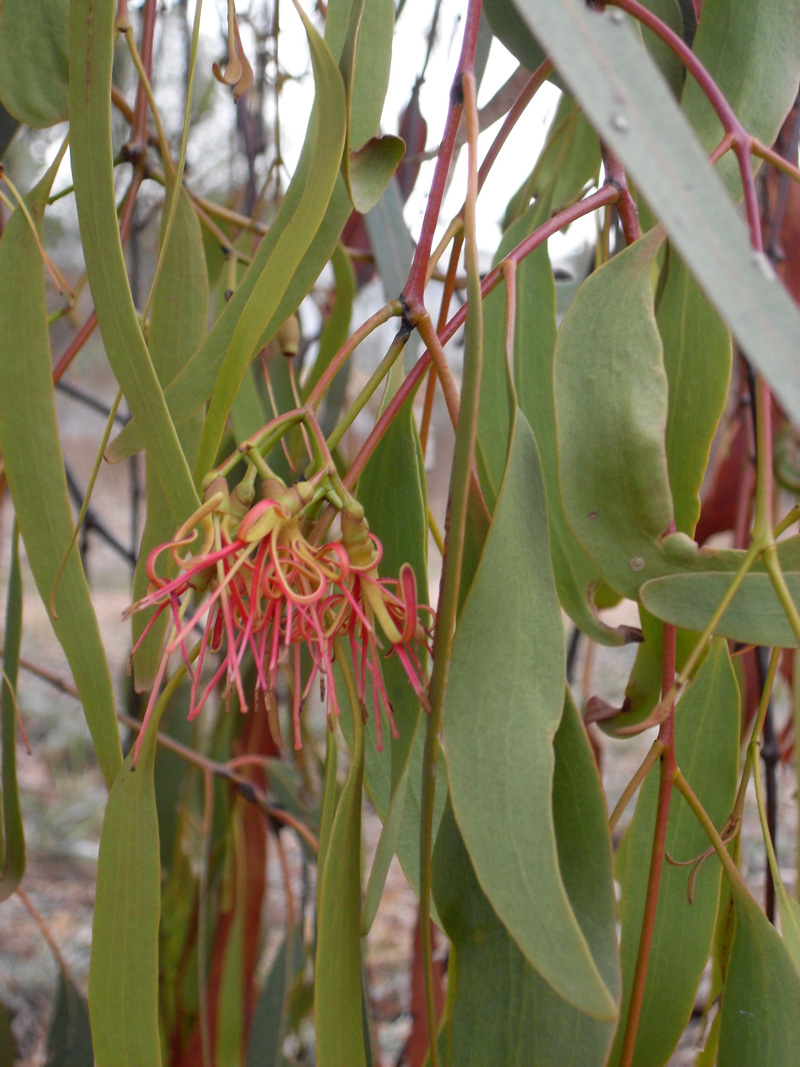
This mistletoe is growing on a peppermint gum tree opposite my house. I have never seen one before that looks similar to this, it is almost like a second species as the leaves and flowers are different from the rest of the mistletoe.
 Samples simmer in an iron pot which proved too popular with students and was submerged in a larger pot, still giving the wonderful properties of iron to the dye baths.
Samples simmer in an iron pot which proved too popular with students and was submerged in a larger pot, still giving the wonderful properties of iron to the dye baths.
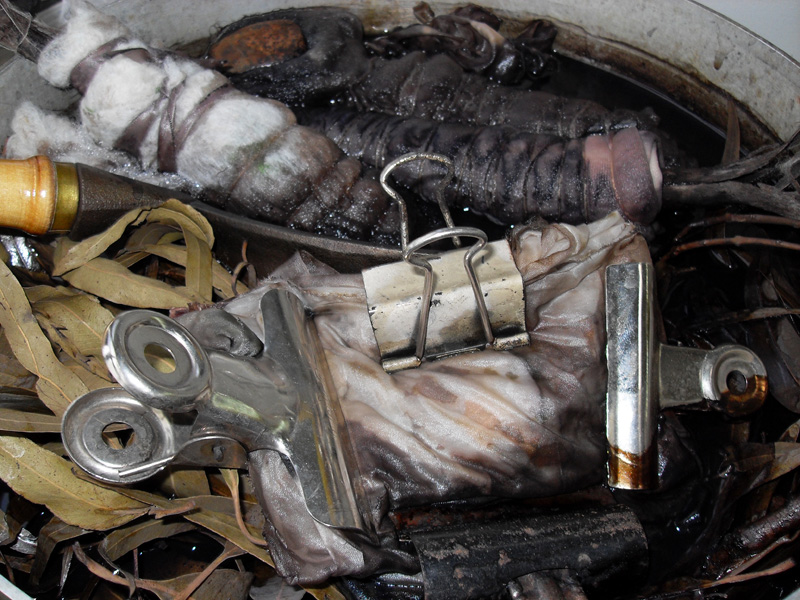
None of the photo's do justice to the beauty of the fabrics. This is silk hot bundled with eucalyptus lehmannii leaves. The iron adds wonderful patterning to the fabric.

Pre felt batting, hot bundled with eucalyptus cordata and dryed mistletoe.
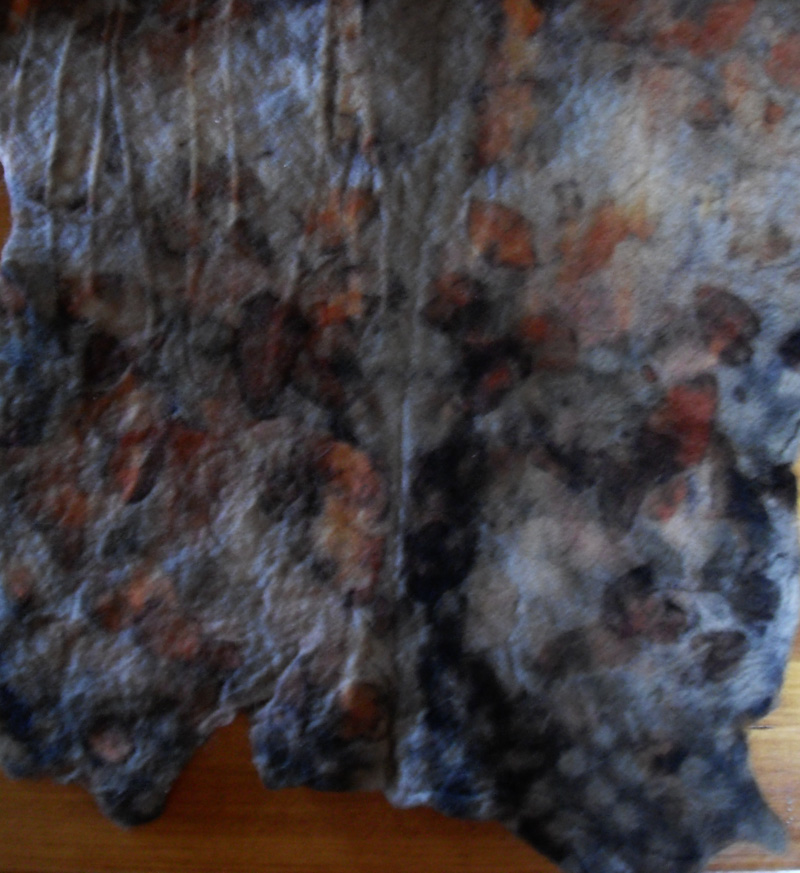
The felt on the left was dyed with the same eucalyptus as the silk bag on the right but with different metals and dyeing methods. A piece of one of my Archie Brennan copper pipe looms will share the memory of the leaves with me while I weave my next small tapestry.
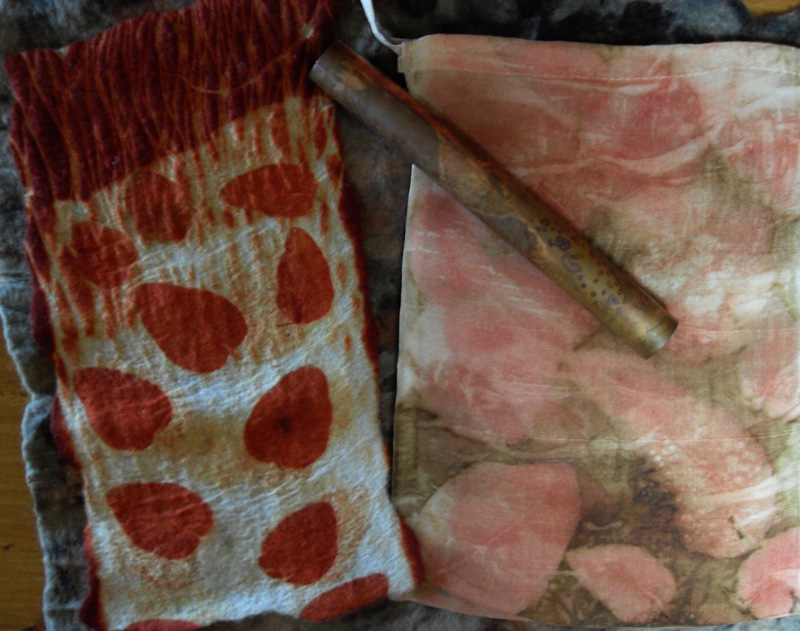
Felt dyed with onion skins, banksia leaves form the resist pattern.
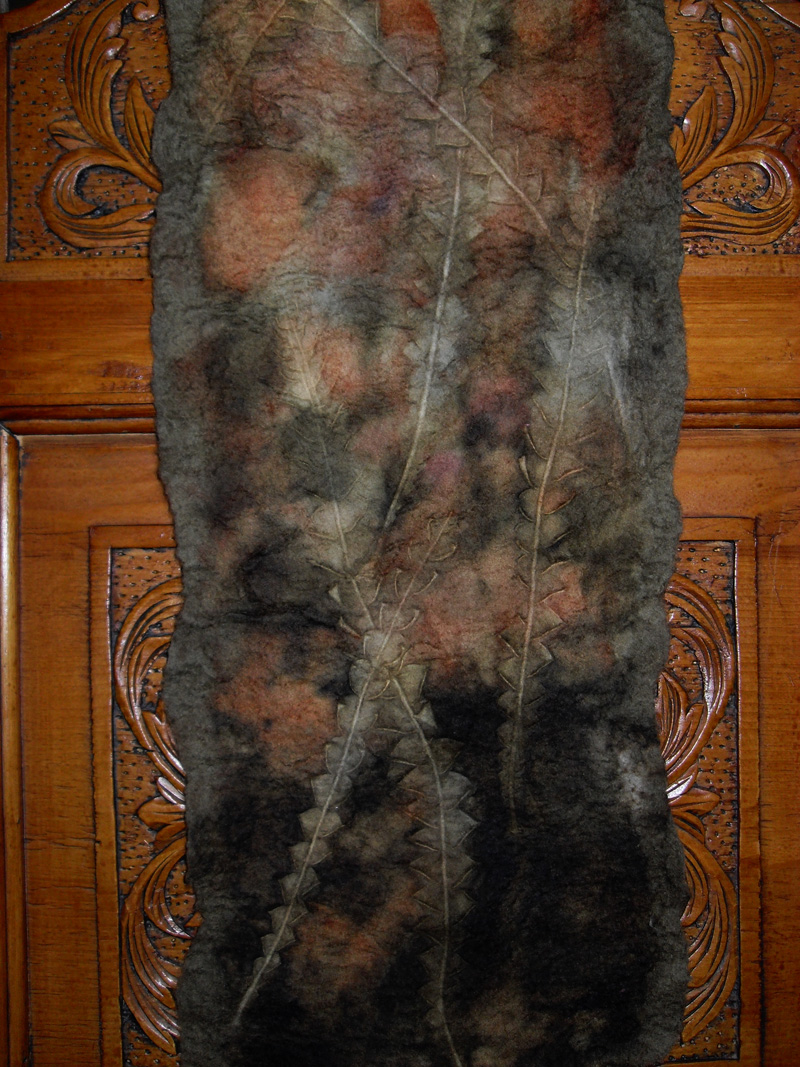
Silk dyed with a combinaton of eucalyptus cordata and eucalyptus sideroxylon.
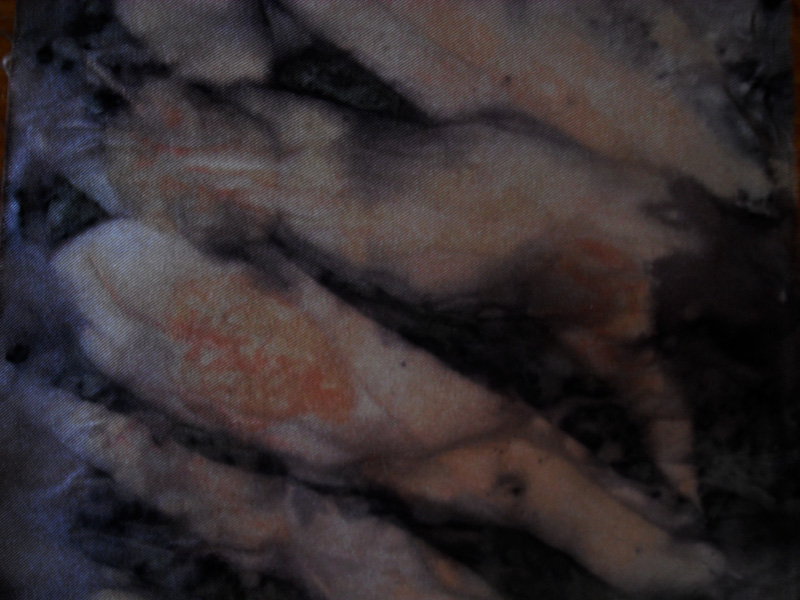
I love the way that you can obtain two different prints by using eucalypts that give different colours and have different sized leaves.
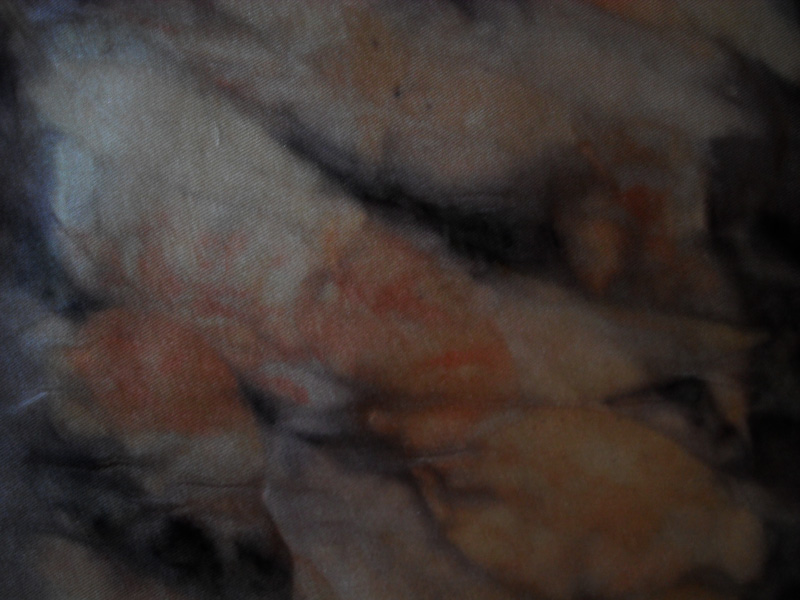
Red and Gold onion skins shimmer on silk.
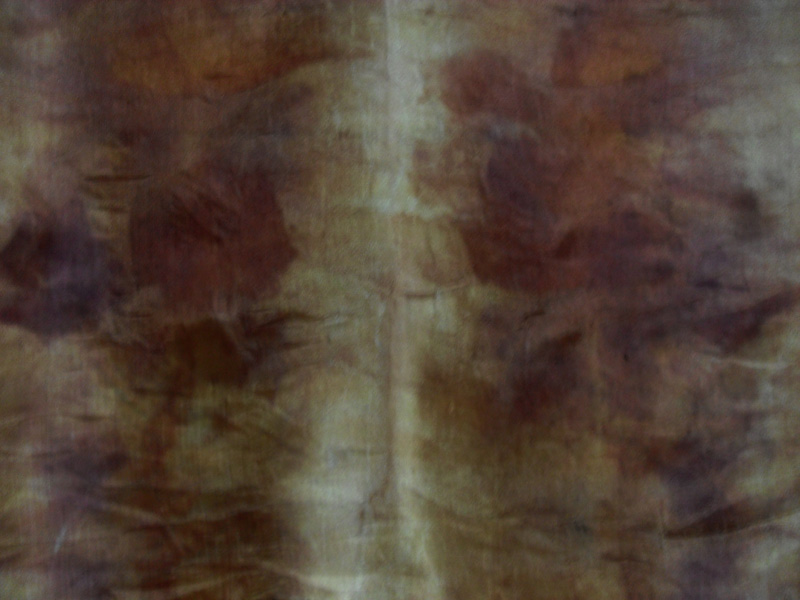
The first two days of the workshop concentrated on dyeing, Wednesday saw us all beginning to make prefelts, dyeing them with the techniques that we had learned. I have never made felt before and on the materials sheet that we were sent before the workshop India suggested we may like to purchase pre felt batting from Beautiful Silks So when a wise woman offers wisdom it is usually a good plan to take their advice.

I cut the batting into 3 pieces, one was dyed green in a copper pot with Choisya ternata, another with banksia cones and the third I tore into pieces and dyed with different eucalyptus and pieces of scrap metal. Silks were dyed and I did make some pre felts pieces that included merino sliver dyed in a variety of the many pots simmering away at the workshop. I took some of Ellie's beautiful English Leicester fleece to incorporate into prefelt pieces. India assured me that it would felt even though it is such a strong fleece compared to the soft, fine merino that we were using. The Leicester prefelts were over stitched with silk thread in patterns of fern fronds in different stages of unraveling. Other prefelts were stitched with wool and silk. The prices were then sewn together and running stitch in silk and wool were added over the entire surface to " tie the piece together "
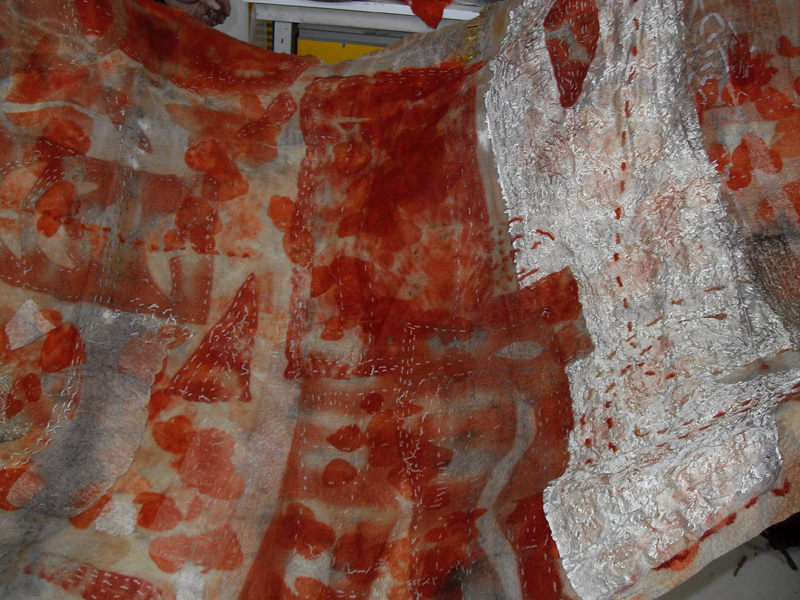
This is one of India's landskins from the Planeta Exhibition at the Ararat Gallery earlier this year.

A rare and exotic India Flint models her landskin made at the workshop as a demonstration.
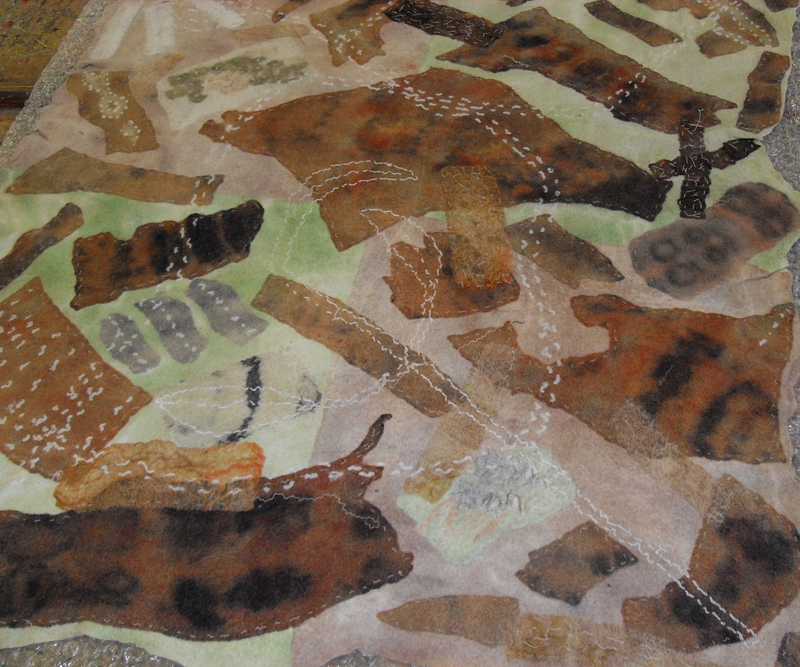
The felting process went ok, typical of me to make such a large piece for my first attempt. Sometimes it is good to just jump in the deep end after all I did go to this workshop to do something outside of the 'box" I feel I work in. A few pieces of silk did not felt, I added some more stitching during the felting process but this was not successful, never mind it is all about learning. I decided to dye my landskin with eucalyptus lehmannii to give a beautiful warm orange. Lehmannii and cordarta leaves along with pieces of scrap metal were folded through the felt and tied up as tightly as I could manage with leftover cotton warp.

India demonstrating nuno felting.
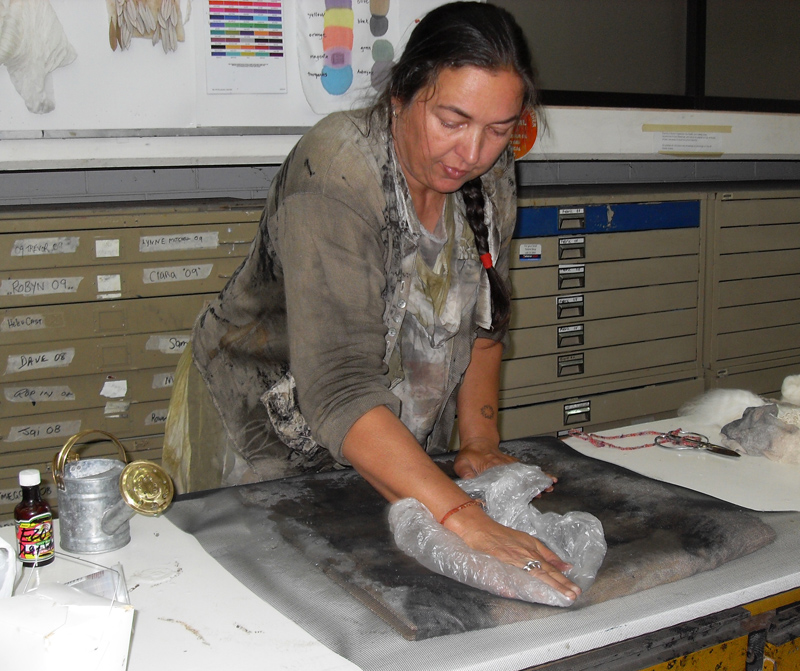 There were many early mornings and late nights but I was determined to finish my felt while I was there as I thought it would be too distracting to continue at home while I have a large tapestry to weave. I stayed at Tafe until about 6.30 on Friday waiting to finish the dye process. As I was to have dinner with a friend I ended up emptying the felt complete with dye bath into a bucket to take home with me. After resting in the bucket for a couple of days I retied the felt a bit tighter and steamed it in my large bamboo steamer for I hour hoping to get some leaf prints.
There were many early mornings and late nights but I was determined to finish my felt while I was there as I thought it would be too distracting to continue at home while I have a large tapestry to weave. I stayed at Tafe until about 6.30 on Friday waiting to finish the dye process. As I was to have dinner with a friend I ended up emptying the felt complete with dye bath into a bucket to take home with me. After resting in the bucket for a couple of days I retied the felt a bit tighter and steamed it in my large bamboo steamer for I hour hoping to get some leaf prints.
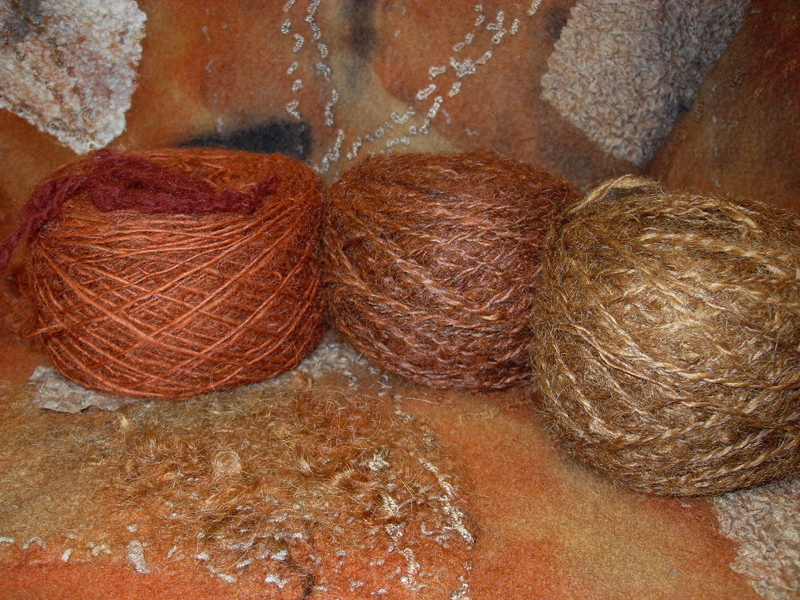
I used some of the dye bath that I brought home with me and divided it equally between a stainless steel bucket and a 'milo' tin. To each dye bath I added a skein of handspun white English Leicester and slowly simmered each one for the same period of time. The ball on the left was dyed in an wonderful heavy commercial aluminum saucepan given to me on the way home by my friend and boss of 10 years Suzy. (It seems poetic justice to use a saucepan from the restaurant as a dye pot now when you think of all the meals we made together in my past life as a Chef) The Leicester handspun wool was dyed with eucalyptus cinerea and the small sample on the top is a piece of handspun cross bred sliver that I bought from Bendigo Woolen Mills. You can see that handspun does not take dye the same as commercially scoured wool. The second ball is the eucalyptus lehmannii dyed in stainless steel and the third ball is the lehmannii dyed in the 'milo' tin, but the star of the show are the tiny pieces of Ellie's fleece shining on the surface of the felt.
The workshop was loads of fun, just what I needed. There are few things as satisfying as dyeing fabric and yarns, eco dyeing can give you lots of unexpected surprises with little impact on the environment.
I have to say with climate change and the world economic crisis ( I won't get on my soapbox here, I reserve that for my morning coffee with Gerard ) and following the Black Saturday fires here in Victoria I have felt very vunerable in the way that I source materials for my tapestries. I am almost totally dependent on two suppliers. I buy kilo's of specially spun un dyed tapestry wool from Bendigo, I know of only one other tapestry weaver who buys the same one as me. I had heard murmurings that they were not going to keep producing this yarn, probably just gossip but it makes me feel very nervous. Kraft Kolour where I have bought my dyes from since 1985 had moved their entire business to their home and were completly burned out in the Black Saturday fires. Bonney and Graham are trying hard to rebuild their lost business and hope to open again mid year. After 30 years of experimenting with dyeing and 17 years of dyeing wool for my tapestries, learning to dye with a system which allows any quantity to be reproduced exactly to my 5 gram samples. With hundreds of meticulously kept records, without those little jars of dye powder they are all totally worthless!
Last Friday was World Environment Day, my friend Helga organized a seminar titled ' The hundred mile lunch' The concept is to source your food locally, so as to have fresh organic food with less impact on the environment and low miles traveled. We seem to still import fresh produce from overseas at the cost of our local producers here in Australia, even though we are supposed to be the smarter generation?
So if you can have a hundred mile diet......without coffee.....ouch!
Can you have a hundred mile tapestry?
Medieval tapestries were woven using only plant dyes with a limited palette of colors. I have studied them, wondered over them, researched them and written many essays about them. Only last year I wrote a scathing essay about the demise of tapestry as the 26th December 1519, when Pope Leo X hung seven tapestries of a series of ten in the Sistine Chapel in the Vatican. The first tapestries ever woven, monumental in scale that were slavishly copied from an artist’s cartoons. So after all that I have to wonder, am I trying to do the same thing? trying to replicate exactly the colours in my current tapestry?
Before I began weaving tapestries I was exploring rug weaving, using white and natural coloured fleeces purchased from local farmers and experimenting with eucalyptus dyes. My beautiful upright four shaft Stanley Dann rug loom has sat idle for many years while I have studied tapestry. So change is in the air and I can feel the wheel slowly turning backwards. Before I left for Warrnambool I had just finished reading Anahita's Woven Riddle by Meghan Nuttall Sayres and while in Warrnambool I borrowed and read her wonderful book, Weaving Tapestry in Rural Ireland, Taipeis Gael in Donegal. I found the book to be so inspiring and admired the tapestries woven in handspun natural dyed yarns.
In a world where our mantra should be Reduce, Reuse, and Recycle we should all be doing everything we can to have less impact on the environment, maybe reducing my expectations of how many colours and how I source my materials could be a good place to ponder.
India's mantra is 'time is your friend' eco dyeing should not be rushed, take things gently and slowly, don't be impatient and the results will reward you.
In a houshold that only knows slow food... slow gardening...slow weaving...slow dyeing should fit in just perfectly!
Many thanks to India for her wisdom and generously shared knowledge, only gained by years and years of research and practice.
I enjoyed the experience immensely. India writes a blog here and you can read a review with details of her fabulous book here and try to source it in your area.
If you ever have an opportunity to participate in a workshop with India, take it, nothing is more valuable than years of experience.....
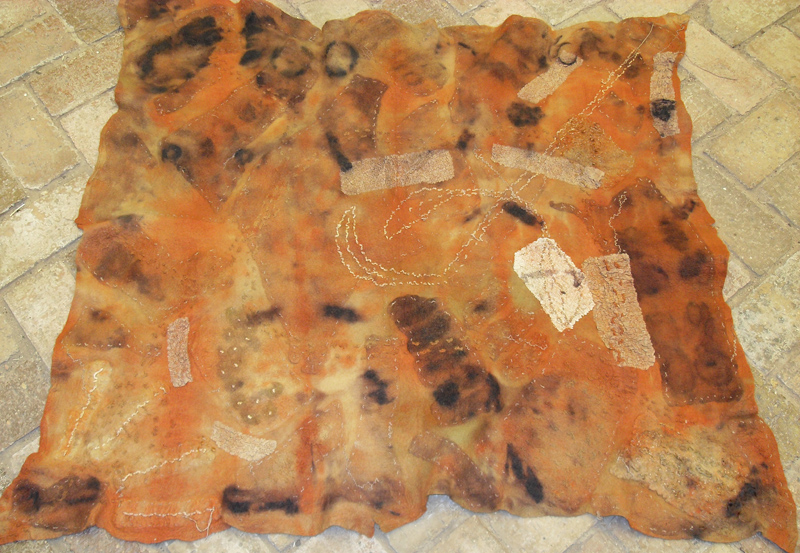
As for my landskin, it needs a gorgeous young Maasai warrior to model it for me. It certainly looks like a skin. I have some dyed wool and silk yarns left over from the workshop and next time I travel on a long journey on the train I will add some stitching. Till then it is back to the loom.
Warrnambool Tafe often run workshops. If you are interested you can be added to the mailing list by contacting Linda at the details below.
Linda Johnstone, Department of Arts,
SWIT, PO Box 674, Warrnambool, 3280
Ph: 03 55 633 610
Email: linda.johnstone@swtafe.vic.edu.au
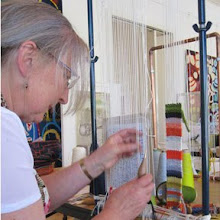


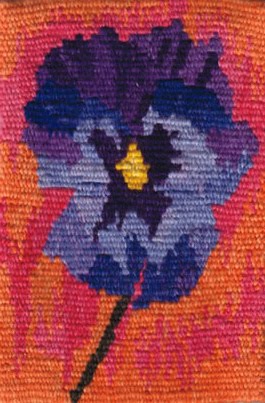
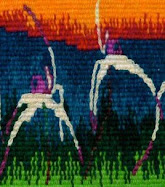


Debbie,
ReplyDeleteThey are gorgeous. Thanks for sharing - and spending time away from that large weaving!
Jennifer
Wow what a great workshop. I too am trying to source my fibres/yarns etc from the locality, but with closing wool mills and a very small population this can be very limiting, I like my 'coffee' too.
ReplyDeleteNatural dyeing sure is a way of life and can't be hurried. BTW your tapestries are beautiful.
thanks for the post
ReplyDeleteit ir impressive
Hi Jennifer, It was lots of fun but alas a tapestry won't weave itself.
ReplyDeleteHi Doe, It is difficult to source local materials, I live in a very rural area as well. Don't think that I could live without coffee, I think I would be a bit grumpy! Manya, thanks for dropping bye. Debbie.
ReplyDeleteThank you for all those kind words Debbie...and also for devising the brilliant technique of fulling the felt on the drafting board! cleverly uses gravity and is much better for one's back.
ReplyDeletebest wishes
india
Thanks India, you are welcome. Often it takes someone who has no idea of what they are doing, to come up with another way. You can now put your tables to a different use. Debbie. P.S. I hope that you enjoyed the podcast.
ReplyDeletefascinating set of photos and thanks for sharing this workshop experience with us!
ReplyDeletewow, the pictures here are just great and i just got india's book. such inspiration.....i found you through shibori girl.
ReplyDeleteWhat a fantastic post. Your workshop with India sounds incredible. Do you think the Tafe will be getting India back again? I will take a look at their website (thanks for the info) and keep an eye on what they have on offer.
ReplyDeleteI have just bought India's book and I am looking forward to trying some eco dyeing. I live out in the bush (Tonimbuk) and am keen to use some of the local foliage etc. for dyeing.
Thanks for this inspiring post.
Jacky.
Hi Jacky, The workshop was well attended and if you contact Linda at the link that I provided, she can tell you if they plan to hold another workshop. India often posts planned workshops on her blog and there is a link in this post. I also live in a very rural area. Thank you for your comment and there is a lot of inspiration in India's book, you just need to start somewhere and what is around you is a great place to begin. I wish you the very best of luck. Debbie.
ReplyDeleteDebbie, the 100 mile rule is so fraught with difficulties, we would have such a sparse pallette to play with. I have abandoned wool - all those sheep pounding the earth bare, and eating out the vegtation is too much. I have been creating a tapestry installation over the last two years from cotton grown with ony natural rainfall in my garden.
ReplyDeleteDorothy The project has certainly led to a greater understanding about the whole textile process, and the labour intensity gives one an affinity to those textile workers in the third world and unerlines that cotton has such a rich history of exploitation of land and poeple. the earthskins make me wish I had time to indulge in felt.
Hi Dorothy, The hundred mile lunch is a challenge but we have a lot of local grains, lentils and chick peas. Helga sourced organic and stone ground spelt for noodles and bread making. Local olives and oil and organic vegetables and medicinal herbs. As I am a professional chef, if you look in my pantry most people would not be able to name most of what you would find in there! I think that if you can support the local farmers markets and buy from them rather than purchase the same produce from the supermarket, that's a good place to begin. I spent the first 16 years of my life on a sheep station near Great Western with around twenty thousand sheep. Now most of the prime Western District, the holy grail of wool production in Australia is planted in Blue Gum plantations for pulp mills, by the way the company that planted them is now bankrupt! Growing cotton in the driest continent on earth is absurd when you look at the environmental cost of irrigation. The workshop was lots of fun, I don't know that I will be making much felt although I like the results. Debbie.
ReplyDelete